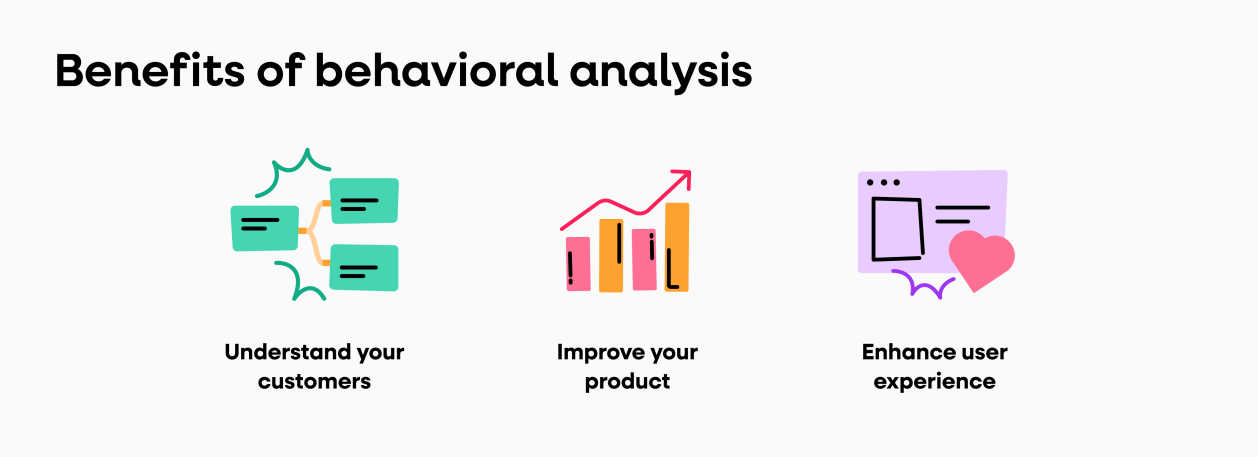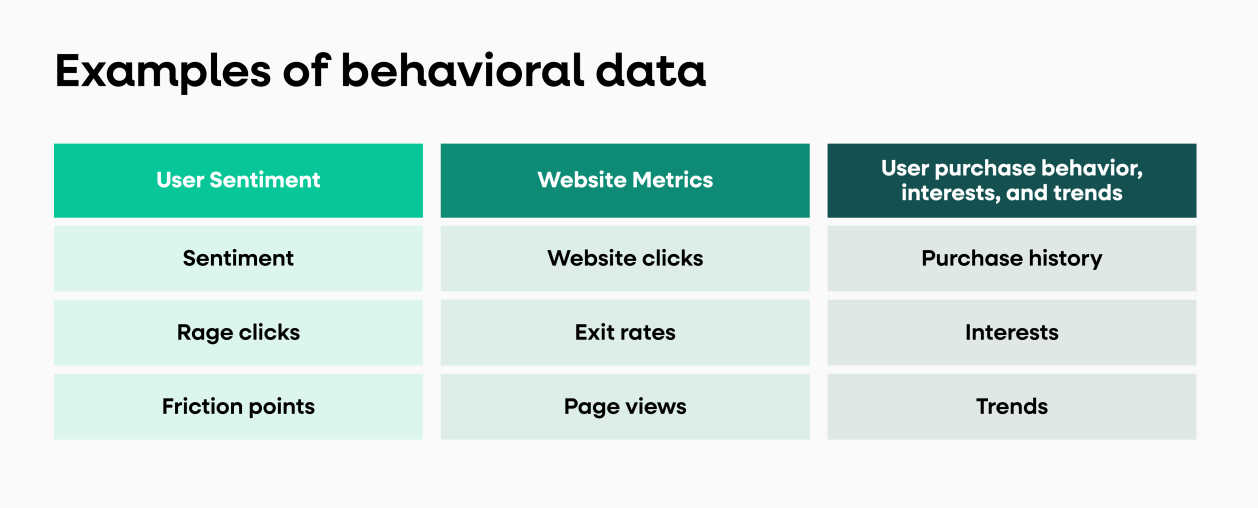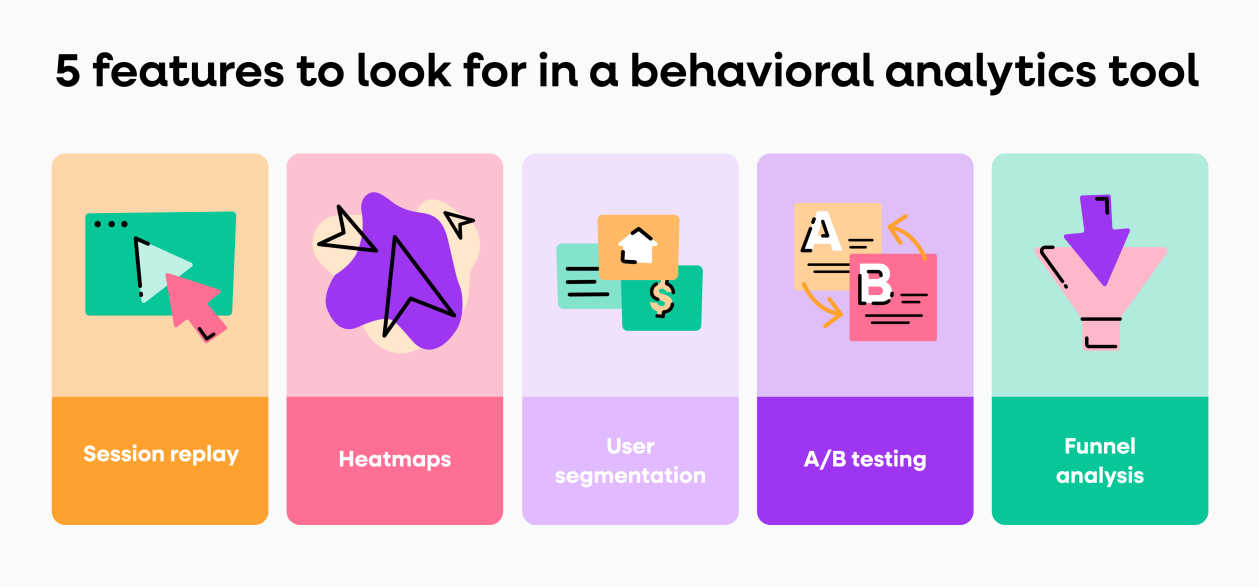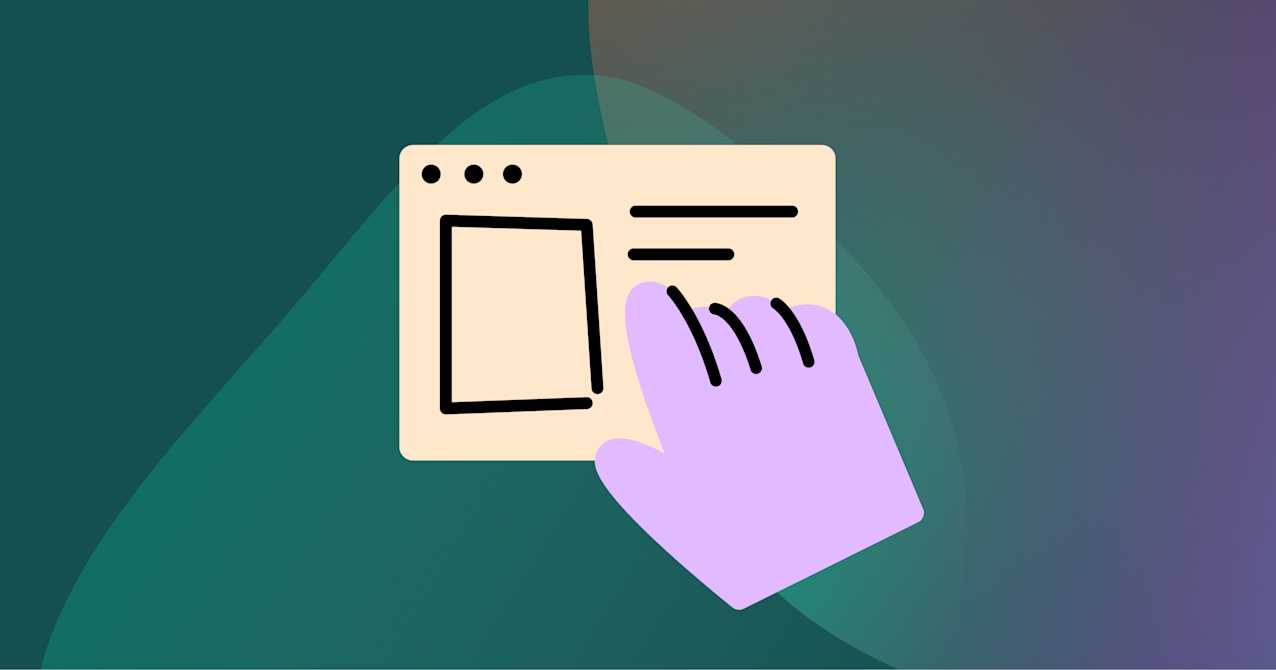Have you ever wondered why certain users spend more time on your app or website than others? Or why so many users leave abandoned carts just one click away from checkout, while others loyally return time and time again?
As business owners and marketers, understanding user behavior is crucial for tailoring strategies that resonate with your audience. Behavioral analytics allows us to quantify and analyze user interactions, turning data into actionable insights. By examining metrics like engagement and actions, we can learn what users are doing and deduce why they're doing it.
Behavior analytics bridges the gap between user actions and business objectives. By employing tools designed for tracking and analyzing behavior (hint hint: tools like Fullstory), we gain access to a wealth of information that helps us optimize the user experience.
Key takeaways
Behavioral analytics combines data and AI to analyze user actions across digital products, uncovering insights for improved decision-making and product enhancement.
Behavior analytics tools leverage features like session replays, heatmaps, and user segmentation to visually decode user actions.
What is behavioral analytics?
Behavioral analytics is a business intelligence method that analyzes user data from websites, apps, and other digital platforms to understand interactions and uncover patterns. By using big data and AI, it helps companies improve products and make informed decisions to better meet customer needs.

Here's how it works:
User data: Data points show us how, when, and why users engage with a platform.
Usage trends: By examining patterns, such as the frequency of use or common navigation paths, you can identify trends that define the user journey.
You can observe real-time data and long-term patterns with tools like Google Analytics. We can paint a complete picture of user behavior with Fullstory insights, which highlight heatmaps and user feedback.
For example, consider how users interact with a newly released feature.:
Initial engagement: You might spot users eagerly exploring the feature upon its release.
Feedback loop: Using behavior analytics, you can closely monitor user reactions, gathering immediate feedback to refine and improve their interaction.
Long-term adoption: Over time, you can track if and how the use of this feature becomes a regular part of the user experience.
Behavioral analytics is a lens through which you share an intimate understanding of your user's needs and preferences. This lens allows you to tailor services and products in a way that feels personal and relevant.
Benefits of deploying behavioral analytics
By uncovering the underlying patterns behind user actions, behavioral analytics reveals customers' likes, dislikes, intentions, and perceptions. This deep understanding eliminates guesswork, enabling you to make informed decisions that drive specific business outcomes such as understanding your customers better, improving your product, and enhancing user experiences.

Let’s see exactly how it helps you get a leg up on your competition.
1. Understand your customers
With behavioral analytics, you can get inside your customers' heads. Think about it as a way to tap into what they love, hate, or are utterly indifferent about.
We're talking about customer journey mapping that helps you spot previously unseen patterns. This insight can boost customer retention rates by engaging them more meaningfully and anticipating their next move.
2. Improve your product
Every click, download, or inactivity speaks volumes about feature usage. By tracking these actions, we're essentially fine-tuning product strategy.
You can identify which features to polish or pitch and predict how changes might impact customer retention and value.
3. Enhance user experience
Now, let's chat about user experience (UX). A top-notch UX directly affects conversion rates and lowers those pesky bounce rates. By analyzing what users do and don’t do, you can craft a smoother, more intuitive experience. This proactive approach doesn't just react to trends; it sets them, keeping users hooked and retention rates healthy.
Behavioral analytics isn't just about numbers and graphs; it's about the stories they tell us.
By embracing this tool, we're not just swimming in data; we're using it to propel your business forward with purpose and precision.
Examples of behavioral data
You can uncover a wealth of insights by examining various forms of behavioral data. These insights help you fine-tune the customer experience, drive engagement, and ultimately, raise revenue.
User sentiment
Sentiment: It's critical to listen to customer feedback. You can gauge users' feelings about a website or product by tracking customer sentiment. This can directly impact user behavior and engagement.
Rage clicks: When users repeatedly click on an element that isn't working, they signal frustration. These events highlight friction points on a site that you need to investigate and fix to improve the customer experience.
Friction points: Watch for parts of a website or funnel where users commonly get stuck. Pinpointing these spots helps you smooth out the path to conversion.
Website metrics
Website clicks: Each click is a chance to learn what grabs users' attention. Tracking these clicks is like reading a story that tells you what works and what doesn't.
Exit rates: High exit rates might spell trouble, signaling that a page isn't meeting user expectations. Identifying these pages allows you to dig into improvements.
Pageviews: The number of pageviews reveals the trends—what's hot and what's not. A spike in views can indicate a successful feature or content piece that's resonating.
User purchase behavior, interests, and trends
Purchase history: By examining past purchases, you can predict future behavior and tailor the shopping experience to increase revenue.
Interests: Scrolling and interaction with content help you identify what users are keen on, guiding you on where to focus efforts for higher engagement.
Trends: We're always looking for rising trends in customers' behavior. This foresight empowers you to stay one step ahead and keep the user base engaged.
Examples of behavioral analytics
Understanding user behavior is critical for enhancing user experiences and securing digital assets in the ever-evolving digital world.

Let's look at the diverse applications of behavioral analytics across industries.
Website analytics
Web analytics tools empower you to track visitor behavior on your websites, helping you understand and improve the user journey.
For instance, funnel analysis identifies when users are dropping off, suggesting where you need to smooth out friction. Additionally, path analysis can reveal how to streamline navigation paths to critical content or conversion points.
Metrics like bounce rate, session duration, and pageviews give you a view of engagement and content effectiveness. This way, you can tailor your web presence to what users are really looking for.
Product usage
When looking at product analytics tools, you gain insights into how customers engage with software. By monitoring metrics like feature usage frequency and time spent on a product, you can pinpoint product experience improvements.
For example, frequent use of a feature may suggest users find it valuable, guiding you to enhance that aspect further.
Conversely, if you notice certain features are rarely touched, you might need to either improve those features or reconsider their relevance in the product suite.
Cybersecurity and unusual behavior
Behavioral analytics is a game-changer in cybersecurity. It's all about tracking and analyzing data to detect unusual behavior that might indicate a security threat or fraudulent activity.
By setting up a baseline of normal activity, analytics systems can promptly alert you to anomalies, like a user accessing the network at odd hours or from a foreign location, which could suggest a compromised account.
Staying ahead of threats means constantly tuning analytics to adapt to evolving security challenges.
Biometrics
Biometrics takes behavioral analytics into the physical world, analyzing physical patterns like voice, fingerprint, and retinal scans for verification purposes. In this ever-connected world, it's crucial for you to include biometric tracking to ensure secure access to devices and services.
This form of analytics isn't just about security but also enhances the user experience by making authentication seamless and almost invisible—a touch or glance and you're in.
From understanding how users interact with your platforms to ensuring top-notch security and easy access, behavioral analytics informs your decisions and shapes users' experiences for the better.
Who is behavioral analytics best for?
Behavior analytics transforms raw data into actionable insights, guiding various teams in enhancing user experience and optimizing performance.
Let's break down who can gain the most from it.
Product teams
Product teams use behavioral analytics to grasp how people interact with their products. With tools like Fullstory, teams can track user activity and engagement, identify and fix website bugs, and analyze the conversion funnel to improve the overall user experience.
Data teams
For data teams, behavioral analytics is crucial. It allows them to monitor and understand large volumes of user data, predicting trends and behavior patterns. This information is key in making data-driven decisions that propel the company forward.
Website teams
Website teams benefit immensely from behavioral analytics by using web analytics to enhance the website’s functionality. They can identify problem areas where users struggle, streamlining the navigation and reducing barriers to conversion.
Marketing teams
Marketing teams leverage behavioral analytics to create personalized campaigns. By understanding user engagement, these teams can tailor their strategies to different audience segments, increasing their efforts' effectiveness.
Customer service teams
Lastly, customer service teams utilize insights from analytics to anticipate customer needs and improve service quality. Behavioral analytics provides them with context about user issues, helping to address concerns and boost customer satisfaction proactively.
5 key features to look for in a behavioral analytics tool
When scoping out the best behavioral analytics software, it's crucial to have robust features that offer a deep understanding of user behavior.

Let's review five essential functionalities a behavioral analytics tool should offer.
Session replay
Session replay tools provide a visual understanding of user behavior by allowing you to watch recordings of user sessions. Seeing how users interact with your website can uncover usability issues that are not apparent through quantitative data alone.
Looking for session replay capabilities means seeking tools that capture every click, scroll, and action users take.
Heatmaps
Heatmaps are essential for visualizing user engagement on a website. Heatmap tools offer a color-coded representation of where users click, move, and scroll. This visual data helps you identify activity hotspots and areas that could improve, giving you actionable insights that improve user experience.
User segmentation
The power of user segmentation lies in its ability to break down analytics into understandable chunks.
By segmenting users into cohorts based on behavior, demographics, or other criteria, you gain the ability to analyze how specific user groups interact with your product differently, which can inform product development and marketing strategies.
A/B testing
Good A/B testing tools can make or break the optimization process. It's about comparing two versions of a web page to see which one performs better. You look for features that allow you to set up, run, and analyze A/B tests efficiently, helping you to make data-driven decisions about design and content.
Funnel analysis
Lastly, funnel analysis is a method for understanding the journey toward a conversion goal, such as making a purchase or signing up. By mapping out the conversion funnel and identifying where users drop off, you can pinpoint areas that need improvement to enhance the overall conversion rate.
Selecting a behavioral analytics tool with these five features will give you the requisite insights to refine your understanding of user behavior and ultimately boost your product's performance.
Get to know your users better
Understanding user behavior is like having a roadmap to your customer's needs and experiences. User behavior tells you exactly what they’re looking for. You can't improve what you don't know, which is why user behavior analytics software is your compass in the digital world.
Unlike traditional analytics tracking page views or scrolls, customer behavior analytics tools dig deeper.
When thousands of users click around, you need more than gut feelings to guide you. Sometimes the sheer volume of data can feel overwhelming, but that's where machine learning comes in. It sifts through the noise and finds the signals that guide your decisions.
Frequently Asked Questions
What are examples of behavioral data?
Behavioral data encompasses users' actions within digital environments, such as websites or applications. For instance, we're looking at which features they interact with most, their path through an app, or how they respond to various prompts.
What is a behavioral analytics tool?
Behavioral analytics tools help us collect and interpret user data to improve services and security. Tools like behavioral analytics from Fullstory can track and analyze how people behave on your website or product, digging into what users want and struggle with.
What is an example of behavior analytics?
Applying User Entity and Behavior Analytics (UEBA) for cybersecurity is an excellent demonstration of behavior analytics in action. It monitors user behavior for potential threats and can even predict risks before they become significant.



